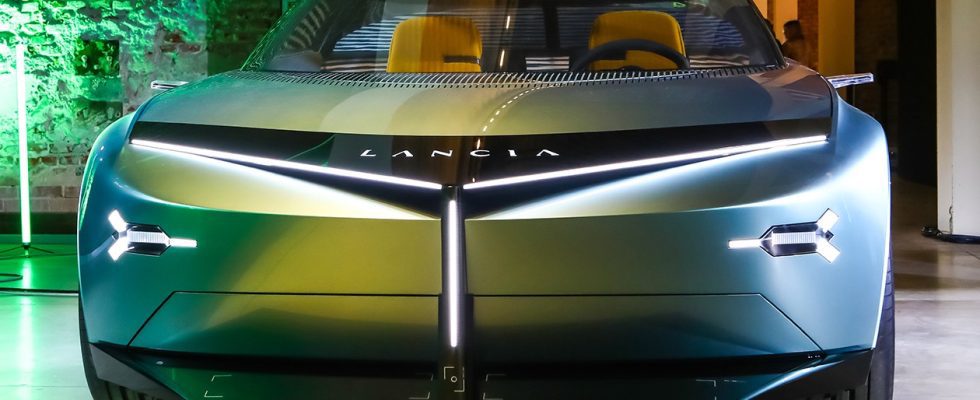What a pity. Lancia’s designers and engineers spent months putting together a prototype just to know that the stylish speedster would never go into series production. But the Pu+Ra HPE is not supposed to do that either. Rather, it should show the direction in which Lancia is developing. A pity. He would be a formidable Stratos successor.
Wait a minute, who actually still knows Lancia? Just ask under-30s. They’ll shake their heads. The brand can look back on 116 years of proud history. Aurelia, Flaminia, Fulvia – what cars! But lately Lancia has disappeared into oblivion after unhappily rebranded offshoots of Chrysler models scared away loyal customers. Lancia has only been active in Italy since 2017, surviving with the almost twelve-year-old Ypsilon. However, it is selling like hot cakes: almost 40,000 units of the old small car were delivered in 2022. Lancia rises in Stellantis’ premium Olympus With the transition from the Fiat to the Stellantis group, Lancia should flourish again throughout Europe. The future of the traditional brand is electric, announced Stellantis boss Carlos Tavares as early as 2021. As part of a ten-year plan, several new models are to be launched and Lancia, together with DS and Alfa Romeo, are to become Stellantis’ premium triumvirate. Not just in Italy, but in eight European countries. Two years later, the first of the 100 planned dealers signed. As part of the Italians’ new agency business, the dealers are only responsible for delivery, maintenance and repairs. The customer orders his car directly from the manufacturer, without a discount and at uniform prices throughout Europe.Ypsilon, Gamma, DeltaFrom mid-2024 they can look after the successor to the twelve-year-old Ypsilon. In 2025, the Italians want to push a slightly stockier, 240 hp variant of the small car, which is still only four meters long. The first appearance of the Gamma is planned for 2026. The 4.70 meter long mid-size sedan then builds on Stellantis’ electrical architecture, which has been completely redeveloped for compact and mid-size models. 800-volt technology and the option of driving semi-autonomously to level 3 are required. In 2028, with the appearance of the even larger Delta, it was all about combustion engines. There are also other key data for the future electric models: Depending on the battery setting – 87 to 104 kWh are planned – ranges of 500 or 800 kilometers should be possible, consumption of 10 to 12 kWh/100 km standard and 32 kilometers range per minute charging time are possible. And if everything works out, the solid-state battery announced by Stellantis for 2028 could also power a Lancia.Back to the Pu+Ra HPEThe concept vehicle presented as part of the Milan Design Week is intended to specify where the journey is headed in terms of design, sustainability and technology. First of all, you could see the flat, 4.45 meter long two-door as a reference to earlier models. Round taillights bring the sporty past of the Stratos back to life from the 1970s. In between sits the new Lancia lettering, while the brand logo, which has also been redesigned, can only be found on the B-pillars and wheels. Lines drawn into the rear window pick up on the characteristic, indicated blinds of the Lancia Beta’s C-pillars, while the rounded panorama roof and the Round carpets follow the basic geometric shapes typical of the brand. This is not built into any series model. Here, however, the glass roof brings plenty of light into the chic, almost plush interior that the brand developed together with furniture manufacturer Cassina. The soft shapes and warm fabrics of the seats are based on his sofa classic Maralunga from 1973. “The interior should be warm and inviting, like a living room,” explains Lancia chief designer Jean Pierre Ploué. And sustainable. The use of recycled materials is one of the pillars of Lancia’s renaissance, says CEO Luca Napolitano. Since Lancia should be a pioneer. With the Ypsilon, the Italians want to make 50 percent of the touchable surfaces from sustainably produced materials, and with the E models even 70 percent. Much of this, Napolitano promises, will be found in the next Ypsilon. The Ypsilon should be more masculine, get away from the image of the women’s car. Just like the new edition of the Fiat 500 at the time. To start with, it is powered by a mild hybrid with 48-volt technology, followed a year later by the E-model… and the operation is clearer Sala, the new virtual interface from Stellantis, is also integrated. The operating system should react to speech in a similar way to Amazon’s Alexa, but understand significantly more commands. Better service is high on Ned Curic’s to-do list. “Technology must be simple and understandable,” demands the Stellantis chief developer. “In some cars, you don’t even understand how to adjust the volume.” It should work better with Sala. Audio, air conditioning and lighting functions are centralized and grouped into a few buttons. The system regulates ventilation, temperature according to the environment, adjusts the music to the mood of the passengers, streams films and provides video games. “Our goal is to control everything with just one touch, click or voice command,” Curic promises. That alone would help to bring Lancia out of the woods. It remains to be hoped that some more from the Pu+Ra HPE will make its way into the series. In 2024 we will know. (SPX)
source site-13
